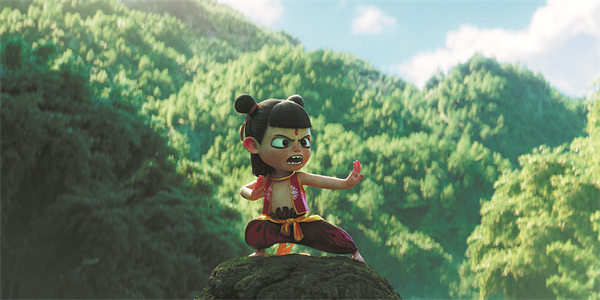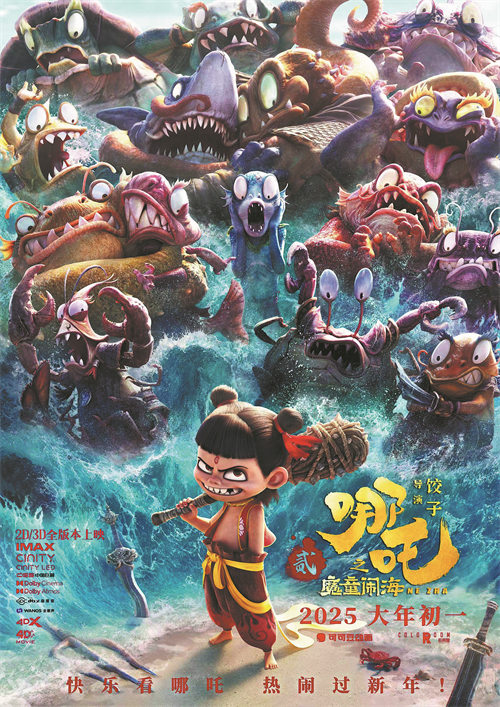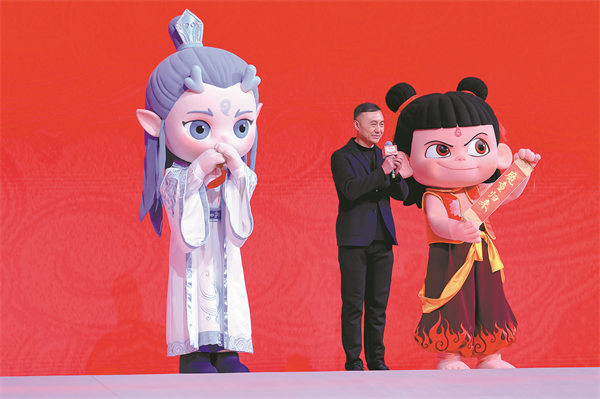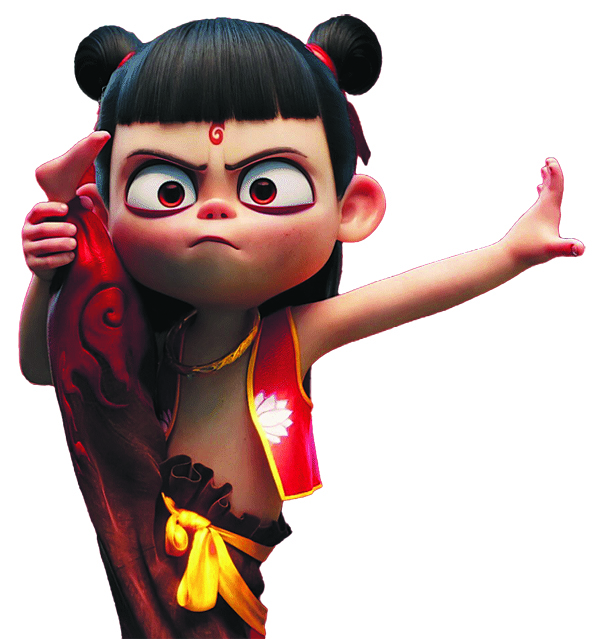
Ne Zha 2, China's biggest box-office sensation, has shattered records to become the world's second-highest-grossing animated film of all time by Friday. [Photo provided to China Daily]
Sequel to 2019 sleeper hit showcases the growing talent of domestic animators and global appeal of the country's strong storytelling capabilities, Xu Fan reports.
He may be just 3 years old but he is amassing wealth and sparking a cultural phenomenon across the country.
Despite his bad temper and unconventional appearance — sporting dark circles under his eyes and uneven teeth — this toddler deity named Nezha occasionally morphs into a powerful teenager, shattering box-office records at an astonishing pace.
Since debuting on Jan 29, the first day of the Chinese New Year, the sequel to the 2019 sleeper hit Ne Zha, Ne Zha 2, by director Yang Yu, better known as Jiaozi (Dumpling), has become China's highest-grossing film in just eight days and five hours. On Feb 7, it replaced Star Wars: The Force Awakens to become the single market's box-office champion. By Friday, the film has raked in over 10.7 billion yuan ($1.47 billion), soaring to be the world's second-highest-grossing animated film.
With its domestic revenue still rising, accounting for over 80 percent of daily ticket receipts this week, "it's almost certain that the film's box-office haul will reach over 14 billion yuan", says Rao Shuguang, president of the China Film Critics Association.
"Ne Zha 2 has not only enhanced a strong foundation for the growth of Chinese animation but has also elevated Chinese cinema's standing worldwide," Rao adds.
Cao Xiaohui, deputy dean of the China Animation Research School at the Beijing Film Academy, says the film supports a promising future for Chinese animators. "Drawing inspiration from the country's rich cultural heritage to tell stories that resonate with modern audiences and showcasing an artistic style infused with Eastern aesthetics on the big screen can serve as valuable directions for local filmmakers to explore," Cao adds.
Lu Shengzhang, the former dean of the Department of Animation and Comics at the Communication University of China, highlights the film's success as a sign of the positive evolution in Chinese animation. With over two decades of development in domestic animation education and the unprecedented expansion of the Chinese film industry, China has nurtured a talented pool of animators capable of competing globally, he says.
"Chinese animators would study in countries like the United States and France to learn animation, but now their skills have reached a top-notch level," Lu further introduces, adding that the stunning visual effects showcased in Ne Zha 2 can also be seen in other blockbusters like Deep Sea and Chang'an. The former is a 2023 fantasy film exploring youth depression, the latter a hit from the same year that recreates literature masters of the Tang Dynasty (618-907).

The poster for Ne Zha 2. [Photo provided to China Daily]
Following its release in Oceania and North American markets on Thursday and Friday, this visually stunning film, representing the pinnacle of Chinese animation, aims to captivate more foreign audiences in around 40 countries and regions. With future markets stretching across Asia, Europe and Africa, the list includes Japan, Greece, South Africa, Egypt and Thailand.
The movie's titular character, loosely inspired by the Ming Dynasty (1368-1644) novel Fengshen Yanyi (Investiture of the Gods), undergoes a significant subversion in its retelling in the 1979 film Nezha Conquers the Dragon King produced by the Shanghai Animation Film Studio, the Chinese equivalent to Disney during the early years of domestic animation.
Beginning with a boldly imaginative scene, Nezha, the youngest son of General Li Jing, and his friend Ao Bing, the beloved son of the East Sea's Dragon King, whose souls share one body after nearly dying in the first film, embark on a new adventure. To win a treasure that would allow Ao to separate from their shared body and regain his own, they must pass a three-round exam set by the highest deities. However, the situation grows increasingly complex, leading them to uncover a thrilling scheme that challenges the notions of good and evil.
Director Yang revealed in earlier interviews that the 1979 film had a profound impact on him, making him want to re-imagine its iconic plotlines, with two particularly challenging scenes being an epic battle in a tumultuous sea and a poignant moment portraying Nezha's near-death experience.
The oceanic scene showcases a massive tripod cauldron, with a diameter of 3 kilometers, submerging into the sea as a magical weapon controlled by the film's top antagonist Wuliang Xianweng, a deceitful deity. It demanded a substantial amount of work to vividly depict the swirling vortex that enveloped it, explains Liu Pan, the film's executive producer.
The tragic moment depicts Nezha struggling to break free from a spell that threatens to dismember him, binding him with countless threadlike needles. The scene features over 600 pieces of his muscles breaking apart mid-air, before reassembling thanks to his supernatural abilities. Liu reveals that the inspiration for this visual effect was drawn from the imagery of shattered glass from huge windows.

Wang Changtian, chairman of Beijing Enlight Media, promotes the film during a Beijing event on Jan 22. [Photo provided to China Daily]
Marking significant progress, the first Ne Zha installment enlisted over 1,600 animators from 60 companies. After five years of preparation and production, including two years polishing the script, the sequel brought together over 4,000 artists from 138 companies, creating 1,900 special shots that account for nearly 80 percent of its 2,400 shots.
Yang, born in Luzhou, Sichuan province in 1980, initially pursued a medical education at the West China School of Pharmacy at Sichuan University. However, he shifted his focus to animation during his junior year upon discovering his passion for art.
A year after graduating, Yang left his job at an advertising company to concentrate on artistic endeavors, relying on his mother's modest pension for financial support for over three years.
In 2008, Yang completed his directorial debut See Through, a 16-minute short film that garnered multiple awards, propelling him to the attention of Coloroom Pictures, the animation division of Beijing Enlight Media, a major studio known for some of the country's biggest projects like director Zhang Yimou's upcoming sci-fi film Three-Body Problem, based on the Hugo Award-winning novel by Liu Cixin.
Yang recalls that the enthusiasm from fans for Ne Zha, the franchise's first film that unexpectedly soared as a dark horse and earned over 5 billion yuan in 2019, gave him the precious opportunity to produce the sequel, which he cherished by assuming it would be his "final work".
"The second film carries such heavy expectations, which is a burden. At the same time, it serves as the motivation that drives us forward," says Yang in the television interview for the China Movie Channel.
In a promotional documentary unveiling the behind-the-scenes stories, an employee at Chengdu Kekedou Animation Film and Television, where Yang is based to lead the core team of the Ne Zha franchise, reveals an interesting fact: Yang occasionally ran from the first floor to the fourth for exercise as the director worried that if he fell ill, it would significantly impact the project.

The iconic landmarks of Chengdu, Sichuan province, display the film's major characters on Feb 8. [Photo provided to China Daily]
Shen Wei, the character designer with a fondness for unusual pets as evidenced by his raising of lizards and snakes, mentions that he was involved in designing most of the new characters, such as the four dragon kings and sea monsters. The most prominent figures include an octopus warrior and a shark fighter.
"The director is caring. He provides text introductions of the characters to help me understand them. If I still can't grasp what he wants to portray on screen, he would either video call me or meet me in person and act out the character," says Shen.
Many moviegoers claim they can empathize with one of the main characters, whether it's Nezha — rebellious yet courageous in following his convictions — or his mother, who provides her son with unconditional love and understanding, enabling him to mature in a unique way.
Lu, from the Communication University of China, says his analysis of the relationship between Nezha and his mother reflects director Yang's bond with his own mother, with this connection imbuing the movie with a powerful and emotional love and highlighting how a family's support can profoundly impact an individual's life.
"What decides a movie's fate is the storytelling. Only a good story can travel beyond borders and resonate with audiences from different cultures," says Lu.
For most Chinese film industry insiders, the overwhelming success of Ne Zha 2 is a strong boost to the once-sluggish market. A month before the film's premiere, 2024 had ended with yearly box-office receipts grossing 42.5 billion yuan, a drop of 22.7 percent compared to 2023.
"Ne Zha 2's popularity is exciting and inspirational, but what the industry should pay more attention to is how we can give other films more screenings to increase diversity and endurance, ensuring the market's long-term development," says Rao from the China Film Critics Association.

The Los Angeles premier of the film at TCL Chinese Theatres on Feb 8, starting the film's Northern American run which was launched on Friday. [Photo/Xinhua]

[Photo provided to China Daily]